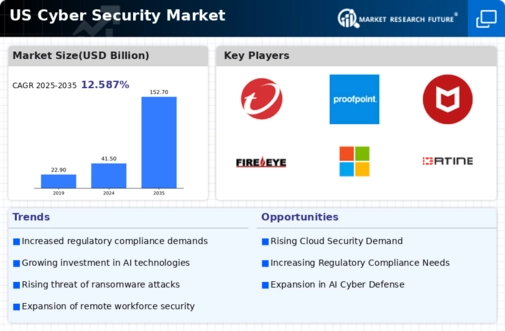Growing Cyber Threat Landscape
The cyber security market is experiencing heightened demand due to an increasingly complex threat landscape. Cyber attacks are becoming more sophisticated, with a notable rise in ransomware incidents and data breaches. In 2025, it is estimated that cybercrime will cost businesses globally over $10 trillion annually, underscoring the urgency for robust security measures. Organizations are compelled to invest in advanced security solutions to protect sensitive data and maintain operational integrity. This trend is particularly pronounced in sectors such as finance and healthcare, where data protection is paramount. As a result, This market is projected to grow at a CAGR of approximately 12% through 2027., driven by the need for comprehensive security strategies to combat evolving threats.
Increased Adoption of Remote Work
The shift towards remote work has transformed the cyber security market, as organizations must now secure a distributed workforce. With employees accessing corporate networks from various locations, the attack surface has expanded, making it imperative for companies to implement robust security protocols. In 2025, it is projected that remote work will account for over 30% of the US workforce, necessitating investments in secure access solutions and endpoint protection. This trend has led to a surge in demand for Virtual Private Networks (VPNs) and Zero Trust architectures, which are designed to safeguard remote connections. Consequently, This market is likely to see accelerated growth as businesses prioritize securing remote access to protect sensitive information..
Regulatory Pressures and Compliance
The cyber security market is significantly influenced by regulatory pressures that mandate stringent compliance measures. In the US, regulations such as the Health Insurance Portability and Accountability Act (HIPAA) and the General Data Protection Regulation (GDPR) impose strict requirements on data protection and privacy. Organizations face substantial penalties for non-compliance, which can reach millions of dollars. This regulatory environment compels businesses to invest in cyber security solutions to ensure adherence to legal standards. As compliance becomes a critical business priority, the cyber security market is expected to expand, with organizations allocating an increasing portion of their IT budgets—estimated at 10-15%—toward security initiatives to mitigate risks associated with regulatory violations.
Rising Awareness of Cyber Security Risks
The growing awareness of cyber security risks among businesses and consumers is a key driver of the cyber security market. High-profile data breaches and cyber incidents have heightened public consciousness regarding the importance of data protection. As organizations recognize the potential financial and reputational damage associated with cyber threats, they are increasingly prioritizing cyber security investments. Surveys indicate that over 70% of businesses plan to increase their cyber security budgets in 2025, reflecting a proactive approach to risk management. This heightened awareness is likely to fuel demand for a wide range of security solutions, from firewalls to advanced threat intelligence platforms, thereby propelling the cyber security market forward.
Emergence of Artificial Intelligence in Security
The integration of artificial intelligence (AI) into the cyber security market is revolutionizing threat detection and response capabilities. AI technologies enable organizations to analyze vast amounts of data in real-time, identifying anomalies and potential threats more efficiently than traditional methods. By 2025, it is anticipated that AI-driven security solutions will account for nearly 20% of the overall cyber security market. This shift not only enhances the speed and accuracy of threat detection but also reduces the burden on security teams, allowing them to focus on strategic initiatives. As AI continues to evolve, its application in the cyber security market is expected to expand, driving innovation and improving overall security posture.

























Leave a Comment